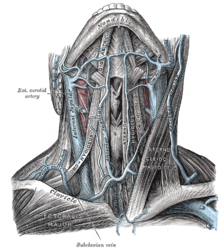Queckenstedt sign

Neck veins, anatomical position on the hyperextended neck: Right internal jugular vein , left external jugular vein
The Queckenstedt sign or the Queckenstedt test ( English : Queckenstedt's sign, also: Queckenstedt-Stookey test), named after the German neurologist Hans-Heinrich Georg Queckenstedt (1876–1918), is a test for clarifying a passage obstacle in the spinal canal .
In healthy people, by compression of the jugular veins , a cerebrospinal fluid pressure to achieve that one as part of a spinal tap evidence or by a faster draining of cerebrospinal fluid can be measured objectively. If this does not happen, a constricting intraspinal process, for example a tumor, above the puncture site can be concluded. By imaging techniques such as magnetic resonance imaging test has become obsolete in the clinical routine.
Original description
- H. Queckenstedt: On the diagnosis of spinal cord compression. In: Deutsche Zeitschrift für Nervenheilkunde , 1916, 55: 325-333, doi : 10.1007 / BF01733057 .
literature
- Ekkehardt Kumbier , Uwe K. Zettl : Hans Queckenstedt (1876-1918). In: Journal of Neurology. 264, 2017, pp. 1032-1034, doi : 10.1007 / s00415-016-8315-9 .
- Pschyrembel - Clinical Dictionary . CD-ROM version. 259th edition. Walter de Gruyter Verlag, Berlin / New York 2002, ISBN 3-11-016523-6
Web links
- Queckenstedt's phenomenon at www.whonamedit.com